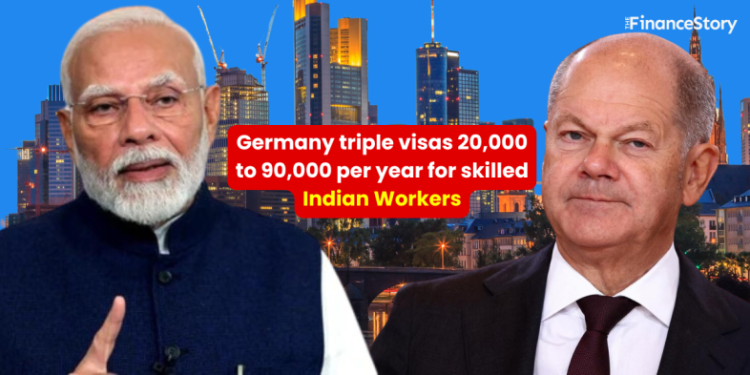- German Chancellor Olaf Scholz recently visited India for the 18th Asia-Pacific Conference of German Business (APK 2024), held in New Delhi from October 24-26, 2024.
- This visit is part of Germany’s strategy to strengthen its ties with India, particularly as its relationship with China deteriorates.
- Following discussions, eight agreements were signed, covering a range of collaborations.
- Here is a breakdown.
Context of the German Chancellor’s India Visit:
- The visit comes at a pivotal moment for Scholz, who is facing challenges in revitalizing the German economy.
- It has been impacted by the ongoing war in Ukraine and increasing competition from China.
- Meanwhile, Indian Prime Minister Modi recently returned from the BRICS summit in Russia, highlighting India’s complex geopolitical positioning.

Key Issues on the Agenda:
Submarine Contracts
- India plans to order six new submarines as part of its strategy to counter China’s growing naval presence in the Indo-Pacific region.
- Germany’s Thyssenkrupp AG, an industrial engineering and steel production multinational conglomerate is bidding for a $4.8 billion contract with India.
- This indicates a growing defense collaboration between the two nations.
Military Hardware Diversification
- In light of Russia’s invasion of Ukraine, India is looking to diversify its sources of military equipment.
- Scholz’s discussions with Modi will likely touch on how Germany can assist in this diversification strategy, especially given India’s historical reliance on Russian arms.
Economic Cooperation and Trade:
- The German government aims to reduce its reliance on China for trade and is identifying India as a potential alternative.
- Germany is already India’s largest trading partner in Europe, with bilateral trade reaching $22 billion in 2020-21.
- Scholz is expected to address the bureaucratic challenges faced by German firms operating in India, as over 60% of these businesses cite red tape as a significant obstacle.
Geopolitical Dynamics
- Scholz was to discuss the ongoing war in Ukraine with Modi, particularly in light of India’s balanced stance between Russia and the West.
- The German Chancellor highlighted India’s unique position to engage with both Russia and Ukraine.
Labor Migration and Workforce Needs
Picture this: Germany, known for its bustling beer gardens, delicious sausages, and precision engineering, suddenly finds itself in a bit of a pickle.
Germany is currently facing a significant labour shortage. According to recent reports by Statista, there are over 770,301 job vacancies across more than 70 industries, including transport, manufacturing, healthcare, and IT.
Yes, you read that right! And they’re looking beyond their borders for a solution.
As of 2023, around 45.8 million people were employed in Germany, but the country still has a significant labor shortage.
Ambitious plan – to welcome a whopping 447,055 skilled immigrants across various sectors.
The big news? Germany is tripling the number of skilled work visas for Indian professionals—from a modest 20,000 to a staggering 90,000 per year!
This initiative opens the door for skilled Indian workers to fill crucial roles in Germany’s economy, fostering collaboration between the two nations and addressing workforce gaps.

Sectors facing the most talent shortage in Germany
- IT and Software: High demand for IT professionals with relevant experience; cross-functional opportunities
- Accounting & Finance: In-demand roles include Account Managers and Business Analysts.
- Human Resources (HRs) Expected 18% growth in HR jobs; attractive to foreign skilled workers with training.
- Engineering: Areas like automotive, electrical, and mechanical engineering.
- Sales & Marketing: A large number of sales jobs; marketing roles are also in demand.
- STEM: Shortage of STEM professionals with 338,000 experts needed; significant role in economy and industry.














